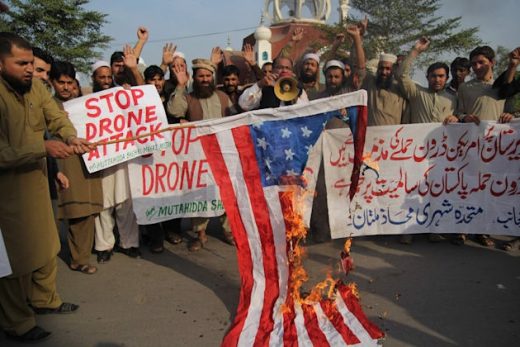Israel reportedly used a remote-controlled gun to assassinate an Iranian scientist
America’s drone strike program needs a low-tech fix

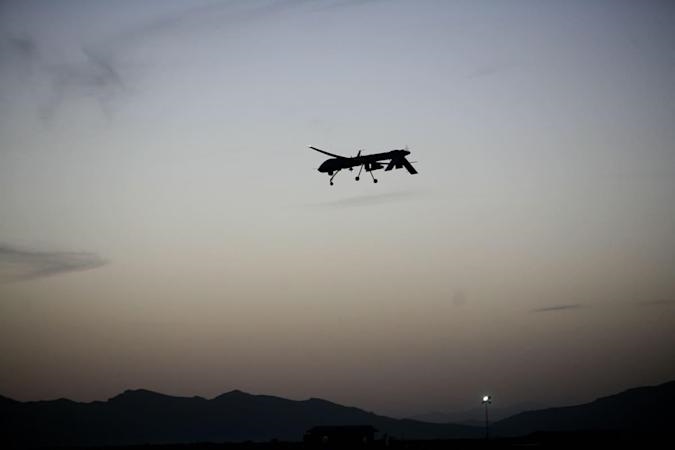
Last week, The Intercept released a trove of classified documents (provided by an unnamed source) relating to America’s use of unmanned aerial vehicles (UAVs) as weapons of assassination. These activities took place between 2011 and 2013, throughout both active combat areas in Iraq and Afghanistan and nations like Yemen and Pakistan. And while plenty of people are discussing the shortcomings of human-controlled UAVs, nobody’s talking about how to fix them. Could the answer be more technology like the fully autonomous weapon and surveillance platforms that the Department of Defense (DoD) is developing? Or, when it comes to aerial assassinations, is less more?
The US government has been conducting drone strikes outside of declared war zones since 2002. The CIA has traditionally carried out these covert operations. However, since the start of the Second Iraq War, the Department of Defense’s Joint Special Operations Command (JSOC) has aggressively positioned itself to be a player. This has created a turf war of sorts between the two groups with each side vying for operational control of the program.
“Our entire Middle East policy seems to be based on firing drones,” Lt. Gen. Michael Flynn, former head of the Defense Intelligence Agency, told The Intercept. “They’re enamored by the ability of special operations and the CIA to find a guy in the middle of the desert in some shitty little village and drop a bomb on his head and kill him.”
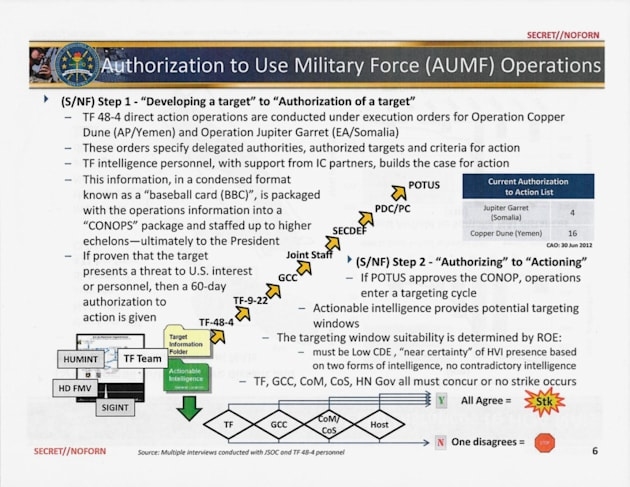
Regardless of which agency is planning the strike, the overall process of identifying, tracking and killing a target is the same. Targets are usually discovered through Signals Intelligence (SIGINT) and Communications Intelligence (COMINT) — specifically eavesdropping on mobile communications by tracing cellphone calls and skimming SIM card data.
Task forces first work alongside intelligence agencies to “develop” a target — that is, identify someone high up in the al-Qaida chain of command based on SIGINT work. This information is then condensed into a mini-dossier, called a “baseball card,” which works its way up a lengthy chain of command comprised of various cabinet officials and diplomats until it eventually lands on the president’s desk. Once the president approves the assassination, JSOC has a 60-day window in which to find and kill the target. The entire process is known as “Find, Fix, Finish” in JSOC nomenclature.
These strikes, according to a very broad legal framework the Barack Obama administration put forth in 2013, are only supposed to be undertaken if specific criteria are met, including: The operation has to have a “near certainty” that the target can be killed; the agencies feel that the target cannot be captured; and the target is an “imminent” threat to the US and its interests.
These criteria, however, are not being examined without bias. As a US Army-Surgeon General Study conducted between 2005 and 2007 found that less than half of soldiers and Marines felt that non-combatants deserve to be treated with respect. More than a third of respondents believed torture is acceptable if it saves the life of a team member. Another problem with those criteria is that they’re being applied by the same people that came up with them, so fudging numbers is an issue. “I know the actual number is much higher,” The Intercept’s source said of the government’s tally of civilian casualties. “But they make the numbers themselves so they can get away with writing off most of the kills as legitimate.”
That’s assuming the special operation forces and CIA actually have the guy they’re looking for. These agencies prefer to have an Eye of Sauron-style intelligence-gathering platform — that is, a constant, unblinking view of the target from the moment they’re spotted until a drone strike turns them into a smoldering crater. However, the massive distances that UAVs have to travel from their bases of operations to operation sites limit the number of electronic eyes they can keep on a target. This issue is known as the Tyranny of Distance and it has very real implications on America’s intelligence-gathering abilities.
For flights over Iraq, most UAVs only have to travel about 100 km. For operations in Yemen, that average jumps to 500 km and in Somalia drones must travel more than 1,500 km per leg on average. They can sometimes spend more than half their flight time in transit, rather than loitering over their target, leaving precious little time to perform much meaningful surveillance. What’s more, these distances lead to “blinks” wherein intelligence agencies temporarily lose sight of a target during the handover when a new UAV or manned aircraft relieves the current one.
“I think that having [more drones capable of sharing intel] could improve the situation in some ways. There’s a lot of talk in the papers about blinks, which is a nice euphemism for gaps in the surveillance coverage,” Dr. Ryan Jenkins, assistant professor of Philosophy at the California Polytechnic State University, San Luis Obispo, told Engadget. “It’s clear how deploying a fleet of drones that can eliminate those gaps would improve the reliability of the intelligence. But a lot of the intelligence picture that The Intercept tries to build is using methods that seem unreliable by their nature.”
“[US intelligence services] identify people by their cellphones or they identify people by their gait, as they did with Osama bin Laden,” Jenkins continued. “And it’s not clear how using autonomous weapons would allow us to make more reliable use of that kind of intelligence — whether the person holding the cellphone is the person you think it is, and there’s no guarantee that an autonomous weapon would have keener insight into that than a human would.”
Disconcertingly, SIGINT is even less reliable than tailing a target from overhead as “these sources,” an ISR Task Force study points out, “are neither as timely nor as focused as tactical intelligence.” For example, in 2012, half of the data that went into identifying and tracking targets in Somalia or Yemen came from an average of just 160 and 50 calls per month, respectively.
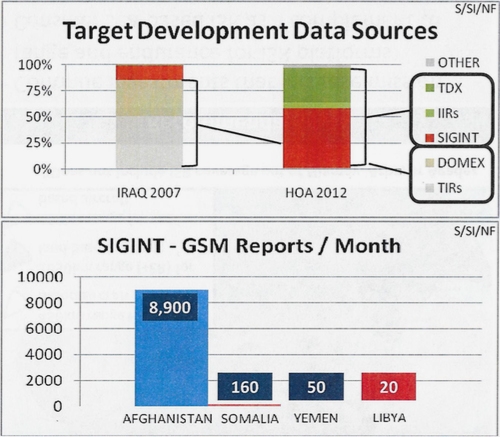
Essentially, the issue is that US intelligence services are trying to determine a target’s culpability (and in turn, decide whether or not to execute them over it) based on a single, easily foiled data source. “I could get on the telephone from somewhere in Somalia, and I know I’m a high-value target, and say in some coded language, ‘The wedding is about to occur in the next 24 hours,'” Flynn told The Intercept. “That could put all of Europe and the United States on a high-level alert, and it may be just total bullshit.”
The CIA and JSOC will confirm a target’s identity via drone-mounted video feeds. However, when this study took place, only the MQ-9 Reaper drone (the Predator’s less common cousin) could capture high-definition video. What’s more, very few UAVs have the necessary “dial number recognition” capabilities to accurately corroborate the video feeds with SIM card data. This results in a whole lot of holes in American intel, and that lack of knowledge can have deadly consequences.
This tactic poses another, larger problem: You can’t extract information from a dead Taliban commander. Since the strikes are being undertaken remotely, the US government has no access to the target’s knowledge, laptop, cellphone or any other source of information that could be used to disrupt terrorist activity. And given that an estimated 75 percent of kill/capture operations end up killing the target, the government is leaving a whole lot of tactical dead ends for itself. In response, JSOC and the CIA are forced to rely more heavily on often spotty SIGINT data or the intelligence from shady host nations. What’s more, these strikes are universally unpopular in the nations that they occur in, not only further hampering efforts to employ more reliable human intelligence (HUMINT) to validate SIGINT data, but also empowering extremist groups to more effectively recruit new fighters.
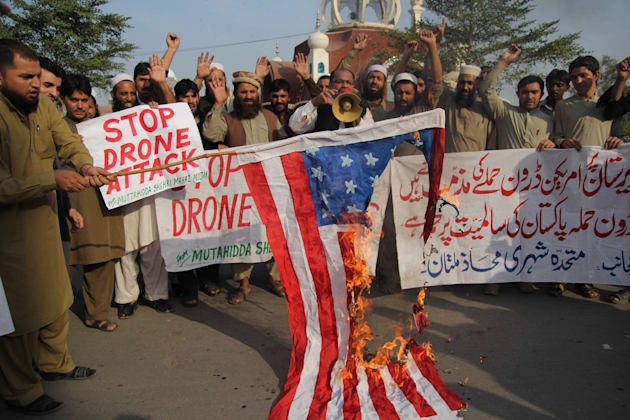
Image Credit: AFP/Getty Images
These strikes are “not just inspiring new people to the cause, but they are also turn people off for a lifetime to being sympathetic to US roles in the Middle East or having any allegiance to the US,” Jenkins told Engadget. “Even people that don’t join extremist organizations will harbor deep resentment against the United States for the rest of their lives.”
What’s more, Jenkins explained, replacing human-controlled drones with fully autonomous models could actually make matters worse. “If people are worried that it is ‘disrespectful’ to assassinate people with remotely piloted drones,” he points out, carrying out assassinations with machines that make their decisions based wholly off of workflow algorithms, “seems like it’s only going to make matters much worse.”
Regardless of its shortcomings, the use of drones in “targeted killings” appears to be here to stay. “It is the politically advantageous thing to do — low cost, no US casualties, gives the appearance of toughness,” Adm. Dennis Blair, Obama’s former director of national intelligence, told The New York Times in 2012. “It plays well domestically, and it is unpopular only in other countries. Any damage it does to the national interest only shows up over the long term.”
For as fast and loose as the Obama administration is wielding these weapons, they remain a viable alternative to putting the lives of US servicemen and women in danger or funding proxy wars. “I’m very hesitant on backing foreign militaries or paramilitary forces or militias,” Clinton Watts, a former FBI special agent and executive officer of the Combating Terrorism Center at West Point, told The Intercept. “I’ve seen that up close before and you’re backing rape-and-pillage campaigns through the countryside, usually. You can’t control them and you don’t have transparency over what they do and it blows up in your face the same way that a bad drone strike does.”
Considering an unending string of unpopular wars in far-off lands, living under constant threat of terrorist activities domestically and a program of morally ambivalent, state-sponsored assassinations against people the government is only pretty sure it should be targeting, the best answer might actually involve less technology, not more.
[Lede image credit: Getty Images]
(71)

